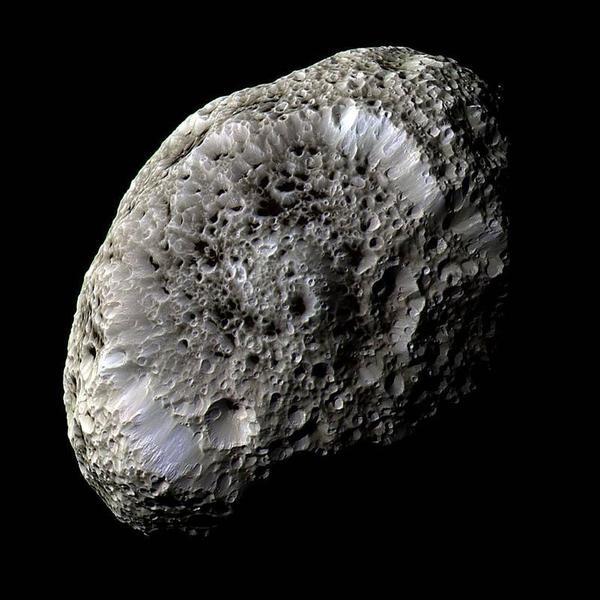
Image: The low density of Hyperion indicates that this satellite is primarily composed of ice with a small amount of rock. Hyperion's rotation is chaotic, its axis of rotation varies so strongly that its orientation in space is impossible to predict. Hyperion is unique for its wasp nest shape, and its surface pitted with strange craters could conceal a vast network of caves.
Hyperion, when observed closely, is one of the strangest objects in the solar system. This small reddish moon of Saturn, very dark, measures 266 km in average diameter. It is an incredibly spongy body of irregular shape.
Hyperion has many dark meteoritic craters on its surface, the largest of which measures 120 km in diameter and 10 km in depth. Its enigmatic, deeply cratered surface has a unique appearance; no other moon in the solar system resembles it, as moons generally have a more or less smooth surface.
Beneath its dark surface, a few dozen meters thick, bright materials can be seen. The low density of Hyperion indicates that this moon is primarily composed of ice with a small amount of rock and many empty spaces. This patatoïde resembles a sponge or a wasp nest.
The walls of the impact craters are bright like a skating rink, while the floors of the craters are a dull reddish color. Of course, there is no lava; the average temperature on Hyperion, like on many moons, is -180 degrees Celsius. On Hyperion, all molecules are frozen, including carbon dioxide, water, methane, carbon dust, and hydrocarbons.
Saturn's small rebellious moon rotates chaotically, as if tossed about in an eccentric orbit. In other words, the object does not rotate at a constant speed or in a constant orientation; its axis of rotation varies enormously. No latitude-longitude reference system has been established for this moon. This is due to the attraction of Saturn and the large moon Titan.
Hyperion resonates with Titan; Titan completes four orbits around Saturn while Hyperion completes three. When Hyperion passes very close to Titan, it undergoes a complex set of gravitational variations because Hyperion is 20 times smaller than Titan. Its rotation and orbit are greatly affected; Titan has a diameter of approximately 5150 km. Titan is larger than Mercury.
This 3:4 resonance with Titan has allowed it to retain all its rotational freedom. Indeed, without Titan, Hyperion's rotation would be synchronous, locked facing the enormous planet Saturn. But this is not the case; while the enormous moon Titan is locked in synchronous rotation with Saturn, the small Hyperion rotates freely on itself in about 13 days and around Saturn in 21 days. This allows it to better distribute the little heat it receives. Hyperion thus lives on an island of orbital stability that allows it to show all its faces to our space probes, to the great joy of scientists.